Male Protagonists in Hitchcock Films
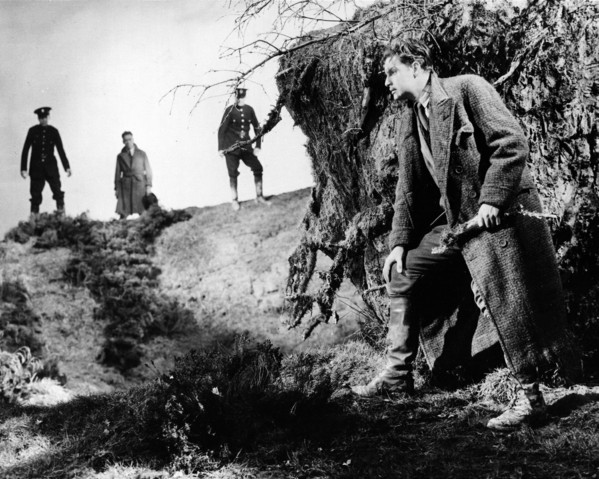
Alfred Hitchcock had been a leading figure of the British movie industry for nearly a decade by the time his films began to receive serious international recognition. His 1927 silent drama The Lodger, coupled with the 1929 thriller Blackmail, had first propelled him to the upper echelon of filmmakers in his native England. It was Hitchcock’s 1935 film of The 39 Steps which became the director’s first major hit in the United States, catching the eye of, among others, his future producer David O. Selznick. The 39 Steps really cemented Hitchcock’s reputation as a director of witty, briskly-paced thrillers. Indeed, the action of The 39 Steps happens at such breakneck speed as to render the story’s inherent implausibility a moot point. No sooner is the audience beginning to understand one set piece than Hitchcock and his screenwriter Charles Bennett have moved on to something entirely different.
Hitchcock’s compulsion with developing taut narratives is what the director would, in his later years, call the “MacGuffin.” Taking its name from an old Scottish folktale, this plot device is, in Hitchcock’s words “the thing the spies are after” — this is to say, that which is of vital importance to the characters in the story but ultimately irrelevant to the overall plot. By ignoring the point of the action, Hitchcock wasted no time in explication and instead focused on action, humor and romance. In The 39 Steps, Hitchcock also developed what would become his typical male protagonist — the ordinary man thrust into extraordinary circumstances.
That theme was one which Hitchcock revisited many times. His obsession with that subject, the historian Peter Bogdanovich has suggested, can be traced back to an incident which occurred when Hitchcock was about five years old. The director’s father wanted to deter his son from pursuing a life of crime and so had his friend, a prison warden, lock young Alfred in a jail cell and walk away for several minutes. That lesson was effective. It was devastating. Understandably, Hitchcock was traumatized by that experience. No wonder, then, that as a filmmaker he should have been so obsessed with stories surrounding the wrongly accused.
After the success of The 39 Steps Hitchcock next returned to that subject with his comic 1938 thriller The Girl Was Young. His protagonist in that film is once again an unlikely suspect who is forced to go on the lam and his implication of a police inspector’s daughter in his escape. Unlike his previous attempt at this story, though, here Hitchcock explores not so much the chase to uncover the real criminal but rather the relationship that develops between his two main characters. A welcome departure from the darkness which permeated his previous film, Sabotage (1936), Hitchcock in this film sacrifices true suspense for slapstick comedy and it is a change of pace that works. While it lacks the polish of his next film, The Lady Vanishes, altogether The Girl Was Young is surely one of Hitchcock’s most underrated directorial efforts.
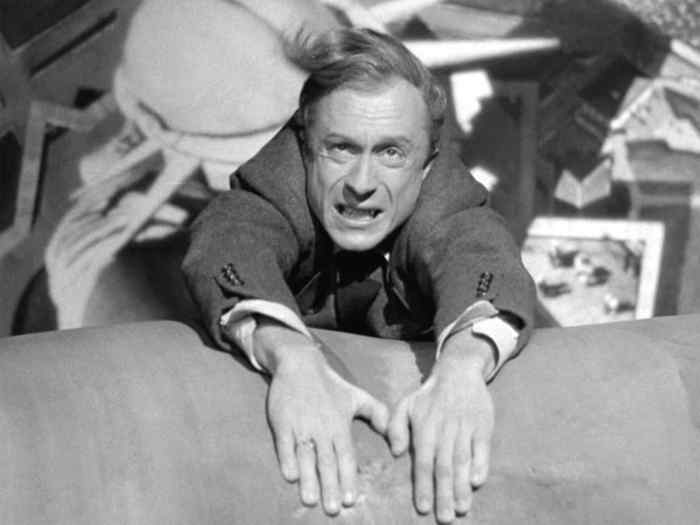
The Girl Was Young is at least as enjoyable as 1942’s Saboteur, which marked the next time Hitchcock would investigate the wrongly accused man archetype. Here he is played by Robert Cummings. It was Hitchcock’s first American film which was set in America — if you discount the anomalous Mr. and Mrs. Smith — and he takes full advantage of his American setting by taking Cummings and his leading lady Priscilla Lane on a cross-country trip from California to New York, culminating with a sojourn to the Statue of Liberty, which plays host to one of the more memorable deaths in the movies. The film was produced shortly after the Japanese bombed Pearl Harbor and Hitchcock used Saboteur to express warnings about homegrown fascism and disloyalty along the lines of other propaganda of the period. But for the most part Hitchcock utilized this film to show that he could do in the States what he had done so well in his native England with The 39 Steps, except with the higher budgets that only Hollywood could provide.
While The 39 Steps was Hitchcock’s first ‘wrong man’ film, it was his 1934 film of The Man Who Knew Too Much, starring Peter Lorre, which launched Hitchcock’s nearly unbroken run of films that fall squarely in the mystery/suspense genre. Hitchcock later revisited his source material when he made the 1956 version of The Man Who Knew Too Much, starring James Stewart and Doris Day. It was the only remake of Hitchcock’s directorial career. Inspired by a trip he had taken to Morocco with his wife Alma, Hitchcock decided to do this version of his ‘wrong man’ story with a distinctly international flavor. This necessitated filming on locations in Morocco and London. The international feel that Hitchcock was going for with this outing was aided immeasurably by the song “Que Sera Sera,” performed in the film by Doris Day, which ended up providing the picture with its only Academy Award. The 1956 film of The Man Who Knew Too Much certainly centers on Hitchcock’s theme of the ‘wrong man’. And while the film is big and colorful and reasonably entertaining, it feels like a more pedestrian effort on Hitchcock’s part. His next film, however, bears a closer examination.
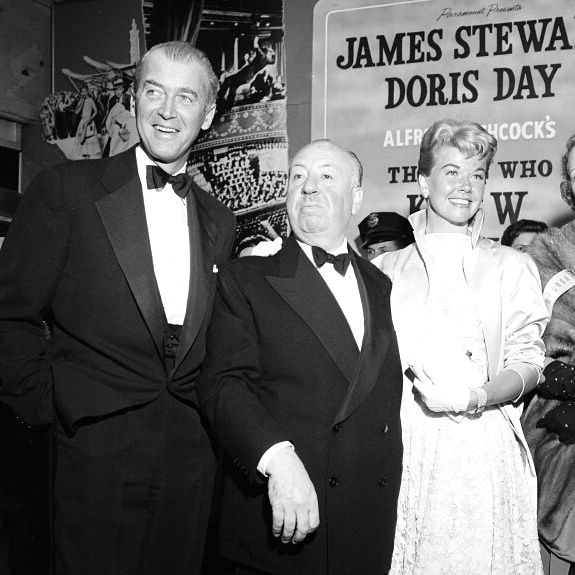
Some have claimed that The Wrong Man (1956) is the most personal of Hitchcock’s films. It is not an unfair assertion to make, given Hitchcock’s childhood experience in a jail cell. Of all the films Hitchcock made with a ‘wrong man’ at its center, The Wrong Man is by far the darkest. That aspect is unavoidable, since the film is based on the actual experiences of Stork Club bassist Christopher Emmanuel Balestrero, who in 1953 was incorrectly identified as a bank robber. The story is a bleak one, with Balestrero’s wife Rose eventually losing her sanity amid lingering doubts about her husband’s innocence. Henry Fonda is perfectly cast as Balestrero, conveying the right sense of urgency and bewilderment in his portrayal, while Vera Miles delivers her best performance as his high-strung wife. Unlike most other Hitchcock movies there are no dramatic chase sequences in this film, nor is Hitchcock’s quirky comic sensibility readily apparent here. But The Wrong Man, in eschewing the qualities which we most associate with Hitchcock, achieves a level of substance to which the director rarely aspired. Watching this film you cannot escape the feeling that the theme of The Wrong Man — suggested by its title — is really what Hitchcock’s films have always been concerned with. The action, romance and other superficial qualities, you could argue, are merely present to make the films more palatable to a typical bourgeois audience.
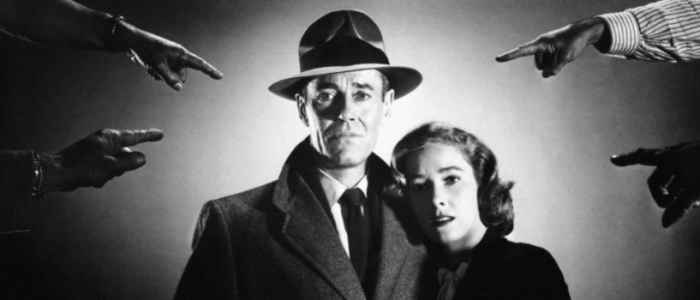
I am unconvinced, though, that The Wrong Man, as Peter Bogdanovich has argued, is truly the most personal film in Hitchcock’s oeuvre. If you want to see a film that was truly personal for Hitchcock, then you should see his 1953 drama I Confess. Hitchcock had been raised in the Roman Catholic tradition and he was understandably drawn to this project, based on an obscure French play, about a priest who hears the confession of a murderer and the moral dilemma each man faces after the priest is charged with the crime. Montgomery Clift stars as the priest, and though he’s not exactly Hitchcock’s ideal leading man, this is an unlikely bit of casting that genuinely works.
Clift delivers a fine performance in I Confess, which should be credited as much to Hitchcock as to himself. Clift was an early and legendary practitioner of Lee Strasberg’s ‘method’ acting, paving the way for Marlon Brando, Robert De Niro, Rod Steiger, Anne Bancroft and others. This inward, meditative style of acting was far removed from Hitchcock’s utilitarian approach to actors. To Hitchcock, the actors were props, no more or less important than the lighting, the sets, and the costumes. This dichotomy between the approach of director and star was evident during the production. During the filming of a crucial scene near the end of the film, Clift is required by the script to look up at a tall building as he is exiting the courthouse, an action which serves as the catalyst for the picture’s climax. Clift protested the inclusion of this business, saying to his director “I can’t just look up, I need a reason to look up.” Hitchcock, who knew how to glare at a dolt, responded that “If you don’t look up then I can’t yell ‘cut’.” And that was that.
I Confess was shot almost entirely on location in Quebec City, and the location is nearly as important a character in the film as Montgomery Clift’s priest. Hitchcock uses the city’s old cobblestone roads and myriad dark alleyways to particularly good advantage here. This has the effect of creating a foreboding atmosphere which suggests early on the terror and misfortune which will be visited on the ‘wrong man’ at the story’s center. I Confess is not your typical Hitchcockian exercise in suspense. The film works best when you view it is an intimate character study, which it is, rather than a dramatic thriller, which it is. Perhaps that is why the film has largely faded from the popular recall. If that is the case, then it is an unfortunate reality because I Confess, steeped in the same traditions as Hitchcock’s strict Jesuit upbringing, is one of the most effective of his ‘wrong man’ films.
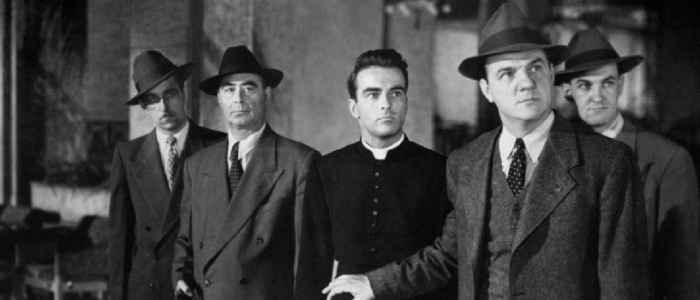
The most famous ‘wrong man’ in any Hitchcock film, though, is surely poor Cary Grant, trying to outrun that damn crop-duster in North By Northwest. It is, with the competition of Psycho, Vertigo and Rear Window, the best-known of Hitchcock’s films today. It is also easily the most consistently enjoyable of that quartet. The film was produced at screenwriter Ernest Lehman’s suggestion that he should write “the Hitchcock picture to end all Hitchcock pictures.” Thematically, it is certainly that. Here you get the man-on-the-run for a crime he did not commit (Grant), the famous MacGuffin (in this case Grant being mistaken for some guy called Kaplan), and the icy blonde love interest with more than a few secrets (Eva Marie Saint). This was reportedly the favorite film of the master of suspense; Hitchcock once said of it that the film had “been boiled down to its purest expression: nothing at all!”
Yet even the most casual analysis of Hitchcock’s films would indicate that the master was being a little unkind to his own body of work. Certainly, few people would disagree that Alfred Hitchcock was a master filmmaker. But why are his films so much better, and better-known, than other entries in the mystery/suspense genre? Well, surely there are many reasons and I am not at all confident of most of them myself. What I do know is this: There was an inherent seriousness to Hitchcock’s preoccupation with the ‘innocent man’ theme which makes even his lightweight films like The Girl Was Young worth more than a passing glance.
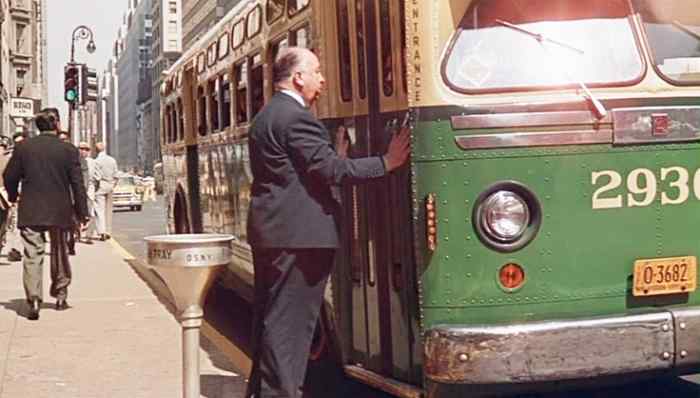
Works cited
Gottlieb, Sidney, ed. Alfred Hitchcock Interviews. Jackson: University Press of Mississippi, 2003. Print.
Guilt Trip: Hitchcock and the Wrong Man. Dir: Laurent Bouzereau. Warner Home Video, 2004. DVD.
What do you think? Leave a comment.











I love Hitchcock’s direction. It really brings out emotion.
Think that The Wrong Man is a tremendously underrated film;if Hitch had an achilles heel it was his reluctance on realism and location shooting,but the downbeat story of an innocuous man unjustly accused of several robberies is based on a true story,filmed in gritty black and white on wintry New York locations,with a fine performance from Henry Fonda in the title role and an even better one from Vera Miles who eventually succumbs to severe depression and a nervous breakdown under the strain.
Good work on providing a thorough analysis of Hitchcock’s films, especially concerning the recurring “innocent man” theme.
The Wrong Man lacks a lot of great aspects one would expect from a director as legendary as Hitchcock.
Hitchcock made great suspense films.
Rear Window is my all-time favourite Hitchcock film (which, given the sheer quality of his other works, is saying something). What lingers for me is that sense of the sweltering day and sticky night, the different sounds drifting past the window, the black humour in so much of Thelma Ritter’s dialogue, and that moment of tension when Grace Kelly enters the apartment. Terrific stuff.
It certainly does help with its setting (apartment block) from the protagonist’s restricted viewpoint, the surrounding environment upping the suspense and paranoia.
There is a moment in Rear Window when the murderer realises who has been watching him all the time and he turns and looks up at Stewart and Stewart draws back quickly. It scared the life out of me and I let out a moan..
Great article. Well researched, and exhaustive in its scope. a good read.
Hitchcock made films with drama so that they would be interesting and people would want to watch them.
The Wrong Man is a personal favourite of mine.
I love Henry Fonda, I love Alfred Hitchcock and Vera Miles is alright (though I find her character here rather disappointing).
Hitchcock was increasingly erratic.
‘Rear Window’ and ‘Vertigo’ are surely Hitchcock’s finest films.
I collect Hitch films on DVD and have yet to watch all of them.
Always a relevant topic of conversation.
Henry Fonda is outstanding.
I love Rear Window. Jimmy Stewart is Jimmy Stewart. Cantankerous, charming, damaged. What more could you want?
The Wrong Man is a unique Hitchcock picture!
Very well done! I love Hitchcock, and I learned so much reading this article. Thank you for publishing!
I think that everyone with a faint interest in cinema should analyse his work.
John, I learned a great deal more about Hitchcock and his films from your article. Thank You.
An interesting article!
Really well done article and look into Hitch. The focus really is on the protagonist almost exclusively. Always a bit funny when you notice how figures of authority in his films often are not looked at in the eye (the first example I can muster is the police officer in Psycho). He really was a bit paranoid, which makes the “wrong man” archetype so much more fascinating.
It’s interesting how Hitchcock combined this characterization of the protagonist with charming antagonists whom often mirrored the hero in some fashion.
Loved the article! It really made me stop to re-think a director I thought I knew more about than I did.
There is a quality in Hitchcock’s films that is almost inexplicable; however, your analysis of his work hits the nail on the head. The subtlety of direction that needs no dialogue (I’m thinking of Rear Window and Vertigo) is something Hitchcock perfected. Your analysis of “the innocent man” makes me want to revisit the films you mention in your article. It will be great to view these with your article in mind – especially I Confess.
I’m forever trying to get my friends to watch Hitchcock with me. This was great.
I thoroughly enjoyed this article; I think your analysis of the innocent man theme and its connection to childhood trauma was clever and intuitive. I enjoyed the exploration of different movies throughout Hitchcock’s lifetime and how diverse he made his movies exploring that specific theme. There is a lot to be said about the editing style of his movies. If you do not show the audience what is hidden in the flowerbeds in Rear Window, than whatever that object is becomes more menacing and subjectively terrifying. For someone that used actors as props, how interesting was it that he got the creme of the crop for his movies from that generation and that certain actors kept coming back for more staring roles such as Cary Grant and Jimmy Stewart.
Strange, interesting score: Minimalist to the extreme, and as stark, bleak, and simple as it gets. Probably mostly just of interest to Bernard Herrmann fans though.
As I am a big Hitchcock’s fan, reading your article was a great pleasure. Entertaining, well written and informative. I’m glad you talked about less “popular” Hitchcock’s films such as Young & Innocent (original title of The Girl Was Young) or I Confess. I agree, Vera Miles’ performance in The Wrong Man is her best. I was lucky to received a letter by the lady herself (answering a fan letter I had previously sent her).
PS: Young and Innocent (The Girl was Young) was originally released in 1937.
I’ve never encountered anyone else who had seen “Young & Innocent” (“The Girl Was Young”). We may be soul mates!
How lucky you are to have received a response from Ms. Miles, by the way. That must have been quite a kick.
Wonderful article! I thought I had seen everything Hitcock, but I have never seen The Girl Was Young, which I will now search for. And yes, it is usually the common trope of the ordinary man facing extraordinary obstacles, though there are a few deviations from this formula. Nicely written article paying homage to a great filmmaker and providing pertinent autobiographical background information that enhances an understanding of his creative genius. Thanks for the film suggestion!
An interesting way of looking at Hitchcock films. As kids, watching his movies with our parents, the game was to always find him in one of his quick appearance scenes.